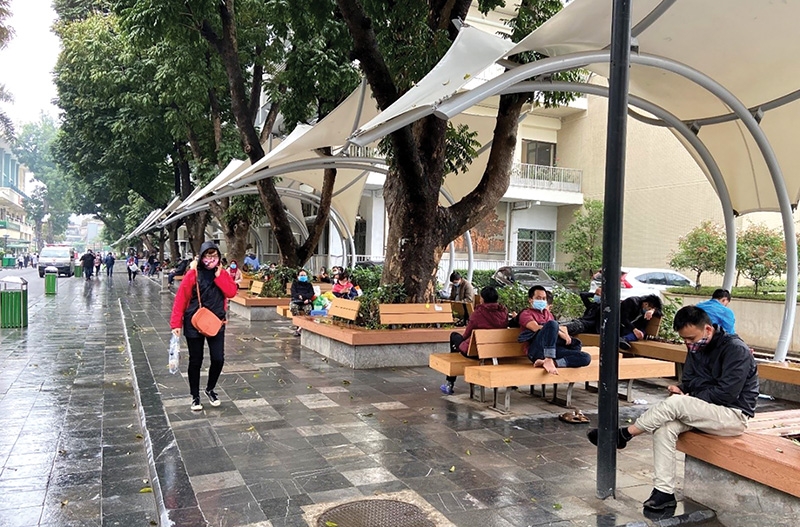The way forward in hospital self-rule
 |
| Le Minh Sang, health specialist at World Bank Vietnam |
Hospitals across the world have been transforming their traditional bureaucratic structures and moving toward autonomisation as a potential solution for improving performance and outcomes. Hospital autonomy aims to reform the relationship between the government and service providers through delegation of decision rights to the hospital management team. The central government envisages public hospitals as independent entities with legal personality and grants hospitals greater managerial autonomy, while retaining hospitals as public institutional identity and their accountability to government priorities.
In the early 1990s, the government embarked on initiatives to encourage the mobilisation of all possible resources in society toward key public services. Over the subsequent decade, this policy became important in mobilising private resources for public service delivery and, at the same time, to ensure access to improved services for the population, especially the disadvantaged groups.
In the health sector, the socialisation policy was built on previous government initiatives to mobilise resources from within society for healthcare, such as the introduction of user fees in public healthcare facilities and contributory social health insurance. The socialisation framework also entails the development of private healthcare providers and the increasing autonomy of public health institutions.
Since 2002, the Vietnamese government has granted increasing levels of autonomy in service delivery, organisation, human resources, and financing to public hospitals. The overarching policy objective is for public hospitals to become financially autonomous, which entails a reduction of direct subsidies for recurring costs and an increase in user fees for curative services.
By 2018, four leading public hospitals were granted full autonomy status and 27.4 per cent of public hospitals could fully self-finance their operations, while 68.4 per cent of public hospitals became partially financially autonomous.
While shifting to the status of financially autonomous, public hospitals still retain a vital role in achieving universal health coverage for the Vietnamese people. The hospital network in Vietnam is dominated by public institutions, which account for approximately 85 per cent of total hospitals, and 94 per cent of total hospital beds, much higher than those in neighboring countries such as China (47 and 81 per cent), Thailand (74 and 79 per cent) and the Philippines (40 and 47 per cent).
In addition, 57 per cent of public hospitals in Vietnam are district hospitals, which are an integral part of the grassroots health network and are responsible for the delivery of preventive health and primary care services. Nearly 19 per cent of public hospitals are specialised care institutions, providing healthcare services for vulnerable groups.
Achievements and concerns
Autonomisation permits public hospitals in Vietnam to mobilise investment capital through different financing modalities. One modality is for public hospitals to take on debt to purchase assets, and another common model is a joint venture for provision of medical equipment through which private investors purchase new medical equipment at public hospitals and charge higher fees for use of these equipment than for publicly provided equipment.
By 2017, central hospitals under the Ministry of Health (MoH) and local hospitals in Hanoi and Ho Chi Minh cities have mobilised more than VND9 trillion ($391 million) through these modalities. In recent years, there have also been large-scale co-branded, co-located hospital models where the private partners contributed a total investment capital of VND2.6 trillion ($113 million) to build new hospitals in Dong Nai and Binh Dinh provinces.
Hospital autonomy has led to an expansion of healthcare services, an increase in hospital utilisation, a growth in total hospital revenues and an improvement in human resources. The most striking trends associated with autonomisation were the rapid extension of “patient-requested services” and the increased utilisation of diagnostic services, leading to a more intensive style of care with more laboratory tests and imaging per case and higher spending per treatment episode.
Hospital revenues increased dramatically in provincial and municipal hospitals, where the largest revenue shares came from user fees for private or patient-requested services as well as surgical and obstetric services. No significant effect of autonomy on total hospital cost was found as hospital managers moved toward greater cost-control across all levels. Autonomisation has led to improvements in human resources, including increased income of hospital staff, boosted motivation and a sense of shared enterprise, as well as training and skills.
Studies showed different levels of patient satisfaction. Interviews with hospital staff suggested that autonomy contributed possibly to user satisfaction, though data did not always support such claims. Those who used “private services” express a higher patient satisfaction index but concerns remain about cost. Researchers found no evidence that hospital autonomy affected in-hospital death rate or complication rate.
The provision of costly profit-generating services for middle- or high-income groups has also raised concerns about the equity and efficiency of public services. Capital mobilisation efforts have generally focused on geographic areas with high revenue potential, resulting in higher out-of-pocket expenses. At the same time, it has not necessarily expanded access to care for those living in poorer areas. Central hospitals and those in large cities, as well as their patients, benefit more than those in poorer provinces and rural areas.
The majority of joint ventures invested in imaging and laboratory equipment, leading to over-provision of laboratory tests and over-utilisation of technologically sophisticated diagnostic equipment. Public hospitals have even established private wards within their campuses to maximise revenue by offering greater choices of accommodation and medical services but charging higher fees than regular services for normal patients.
The weak management of joint-venture projects in autonomous hospitals poses a reputation risk. There have been mounting concerns about non-transparent selection of the private partner, non-competitive procurement of assets, and ineffective appraisal of the financial plan. The joint venture is not required to undergo standard performance monitoring or follow standard financial accounting procedures.
With so much of the capital for equipment investment contributed by hospital staff, who then stands to benefit privately from its use, it is reasonable to think that this would encourage even more supplier-induced demand for services and overuse.
 |
| More autonomisation could permit public hospitals in Vietnam to mobilise more investment capital |
Key challenges
Similar to nations where out-of-pocket payment remains a major source of health financing, hospital autonomy in Vietnam had no discernible effect on healthcare quality. While public hospitals face numerous challenges on the path to full autonomy, there are three key issues.
Firstly, the accountability mechanism for hospital performance is insufficient. The MoH and provincial departments of health are relying mainly on regulation and self-assessment to ensure the quality of healthcare providers. Hospitals are required to self-measure their quality against the MoH’s 83 quality criteria, the majority of which reflect structural and non-clinical factors, and are expected to report to relevant health authorities for evaluation once a year.
However, the hospital quality assessment report is not accessible to the public since there is no mechanism to disclose such a document. Measurement of clinical process and outcomes against key performance indicators is rarely carried out. The national healthcare accreditation system is still under-developed, and only some pioneer hospitals have been accredited against international standards.
Secondly, perverse incentives failed to align hospital behaviours with public objectives. Fee for service is the most commonly used provider payment mechanism in Vietnam. Since 2012, user fee schedules (whose levels are set by the government) have been raised substantially following an official timeline to eventually ensure full cost recovery as facilities become financially autonomous. This creates a perverse incentive for over-servicing.
Public hospitals can also top up staff income from the operating surplus. The socialisation policy encourages public hospitals to raise capital from the private sector to invest in new medical technologies and on-demand services and charge higher fees for the use of those equipment and services. These factors create powerful incentives for hospitals to offer expensive, high-technology services, some of which may be medically unnecessary, but are also interpreted by patients as a signal of quality.
Finally, hospital administrators lack management competencies to perform delegated decision rights. Management competencies are critical for hospital managers to cope with development and operational issues arising from the new context in which decentralisation and autonomy policies have been introduced. However, so far little attention has been paid to health management training in Vietnam.
While almost all public health managers agreed to introduce public-private partnerships (PPP) to overcome budget constraints and infrastructure challenges, a serious shortage of public sector expertise to manage and oversee complex PPP projects might be the most limiting factor in the implementation of health PPPs in Vietnam.
As the government commits to deepen decentralisation consistently, public hospital autonomy in Vietnam is inevitable and irreversible progression. Only with a comprehensive view and proper implementation of different elements of hospital autonomy, can the country achieve the desired outcomes from this reform.
International experience and evidence from in-country studies suggests that Vietnam can make hospital autonomy a greater success through strengthening performance accountability to ensure hospital quality and efficiency, introduce payment systems that promote cost consciousness such as diagnosis-related groups, and improve management competencies for public hospital administrators.
What the stars mean:
★ Poor ★ ★ Promising ★★★ Good ★★★★ Very good ★★★★★ Exceptional
Themes: Healthcare Platform
- Sanofi, Long Chau Pharmacy relaunch medicine blister pack collection initiative
- Takeda Vietnam awarded for ongoing support of Vietnam’s sustainability efforts
- Self-care signals shift towards sustainable healthcare
- DKSH to acquire Vietnamese healthcare distributor Biomedic
- Two national hospitals expand capacity with new facilities
Related Contents
Latest News
More News
- Year-end shopping season faces rising uncertainty (January 14, 2026 | 18:11)
- State sector sees broad-based profit surge as major groups deliver strong results (January 13, 2026 | 17:34)
- HSBC forecasts Vietnam's GDP growth to hit 6.7 per cent in 2026 (January 13, 2026 | 17:33)
- Japfa maintains position in top 10 animal feed firms (January 13, 2026 | 10:18)
- Roadmap shaping up to phase out gas bikes (January 13, 2026 | 10:07)
- FDI momentum accelerates transformation of Vietnam’s plastics sector (January 11, 2026 | 07:00)
- UOB lifts Vietnam growth outlook to 7.5 per cent for 2026 (January 10, 2026 | 09:00)
- Exports cement role as central pillar (January 09, 2026 | 12:37)
- Siemens and NVIDIA expand partnership to build industrial AI operating system (January 09, 2026 | 10:04)
- High targets, hard choices: companies weigh risks in 2026 (January 08, 2026 | 16:58)

 Tag:
Tag:


















 Mobile Version
Mobile Version